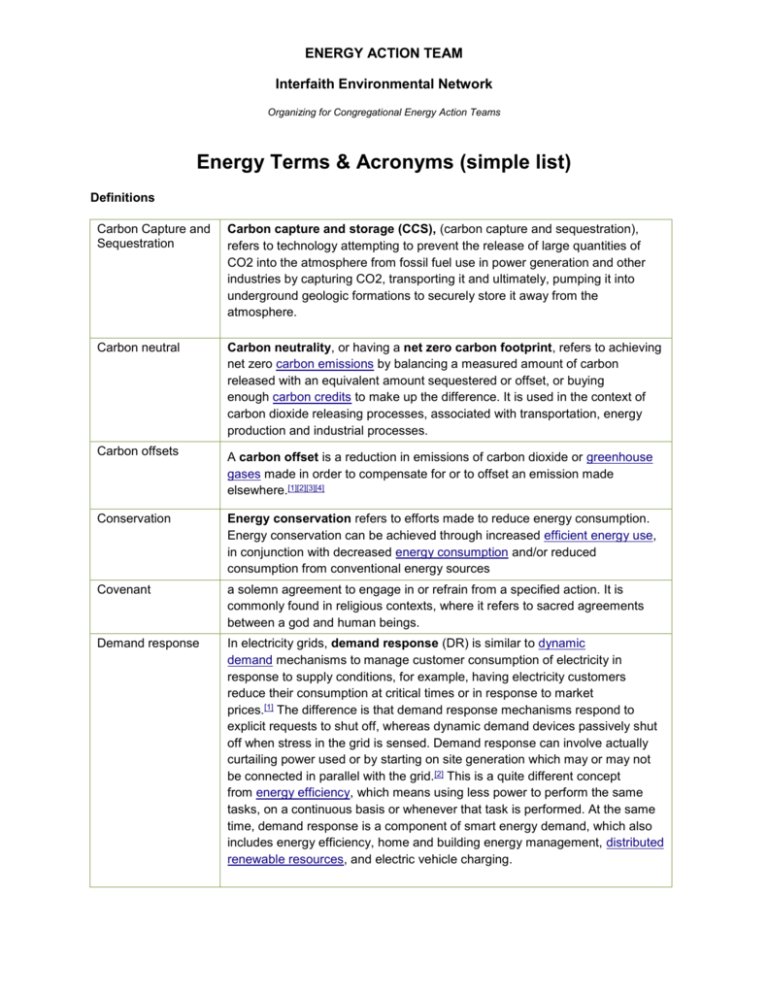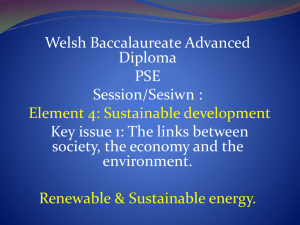Definitions and Acronyms
advertisement

ENERGY ACTION TEAM Interfaith Environmental Network Organizing for Congregational Energy Action Teams Energy Terms & Acronyms (simple list) Definitions Carbon Capture and Sequestration Carbon capture and storage (CCS), (carbon capture and sequestration), refers to technology attempting to prevent the release of large quantities of CO2 into the atmosphere from fossil fuel use in power generation and other industries by capturing CO2, transporting it and ultimately, pumping it into underground geologic formations to securely store it away from the atmosphere. Carbon neutral Carbon neutrality, or having a net zero carbon footprint, refers to achieving net zero carbon emissions by balancing a measured amount of carbon released with an equivalent amount sequestered or offset, or buying enough carbon credits to make up the difference. It is used in the context of carbon dioxide releasing processes, associated with transportation, energy production and industrial processes. Carbon offsets A carbon offset is a reduction in emissions of carbon dioxide or greenhouse gases made in order to compensate for or to offset an emission made elsewhere.[1][2][3][4] Conservation Energy conservation refers to efforts made to reduce energy consumption. Energy conservation can be achieved through increased efficient energy use, in conjunction with decreased energy consumption and/or reduced consumption from conventional energy sources Covenant a solemn agreement to engage in or refrain from a specified action. It is commonly found in religious contexts, where it refers to sacred agreements between a god and human beings. Demand response In electricity grids, demand response (DR) is similar to dynamic demand mechanisms to manage customer consumption of electricity in response to supply conditions, for example, having electricity customers reduce their consumption at critical times or in response to market prices.[1] The difference is that demand response mechanisms respond to explicit requests to shut off, whereas dynamic demand devices passively shut off when stress in the grid is sensed. Demand response can involve actually curtailing power used or by starting on site generation which may or may not be connected in parallel with the grid.[2] This is a quite different concept from energy efficiency, which means using less power to perform the same tasks, on a continuous basis or whenever that task is performed. At the same time, demand response is a component of smart energy demand, which also includes energy efficiency, home and building energy management, distributed renewable resources, and electric vehicle charging. ENERGY ACTION TEAM Interfaith Environmental Network Organizing for Congregational Energy Action Teams Energy Terms & Acronyms (simple list) The DOE defines demand response as: “changes in electric usage by end-use customers from their normal consumption patterns in response to changes in the price of electricity over time, or to incentive payments designed to induce lower electricity use at times of high wholesale market prices or when system reliability is jeopardized.”. Demand response measures include incentivebased programs that pay users to reduce their electricity consumption in specific times (such as load management and direct control to turn down customers’ heaters or air conditioners in an emergency situation), or pricing programs such as time-of-use rates, critical peak pricing, or real time pricing, where customers are given a price signal and expected to moderate their electricity usage in times when prices are high. Most early demand response programs were incentive-based and control-oriented, so the utilities could operate and control the customers’ usage and tell exactly when and how much load changed; these are viewed as reliable, predictable programs that can be trusted as a resource to meet grid reliability needs. Distributed generation Distributed generation, also called on-site generation, dispersed generation, embedded generation, decentralized generation, decentralized energy or distributed energy, generateselectricity from many small energy sources. Most countries generate electricity in large centralized facilities, such as fossil fuel (coal, gas powered), nuclear, large solar power plants or hydropowerplants. These plants have excellent economies of scale, but usually transmit electricity long distances and negatively affect the environment. Distributed generation allows collection of energy from many sources and may give lower environmental impacts and improved security of supply. Downstream All process and actions that take place before you or a point in a process Efficiency Doing more with less. Efficient energy use, sometimes simply called energy efficiency, is the goal of efforts to reduce the amount of energy required to provide products and services. For example, insulating a home allows a building to use less heating and cooling energy to achieve and maintain a comfortable temperature. Installing fluorescent lights or natural skylights reduces the amount of energy required to attain the same level of illumination compared to using traditional incandescent light bulbs. Compact fluorescent lights use two-thirds less energy and may last 6 to 10 times longer than incandescent lights. Improvements in energy efficiency are most often achieved by adopting a more efficient technology or production process Energy audit An energy audit is an inspection, survey and analysis of energy flows for energy conservation in a building, process or system to reduce the amount of energy input into the system without negatively affecting the output(s). Global Warming Global warming refers to the rising average temperature of Earth's ENERGY ACTION TEAM Interfaith Environmental Network Organizing for Congregational Energy Action Teams Energy Terms & Acronyms (simple list) atmosphere and oceans, which began to increase in the late 19th century and is projected to continue rising. Since the early 20th century, Earth's average surface temperature has increased by about 0.8 °C (1.4 °F), with about two thirds of the increase occurring since 1980.[2] Warming of the climate system is unequivocal, and scientists are more than 90% certain that most of it is caused by increasing concentrations of greenhouse gases produced by human activities such as deforestation and the burning of fossil fuels.[3][4][5][6] These findings are recognized by the national science academies of all major industrialized nations.[7][A] Renewable energy Renewable energy is energy which comes from natural resources such as sunlight, wind, rain, tides, and geothermal heat, which are renewable (naturally replenished). About 16% of global final energy consumption comes from renewables, with 10% coming from traditional biomass, which is mainly used forheating, and 3.4% from hydroelectricity. New renewables (small hydro, modern biomass, wind, solar, geothermal, and biofuels) accounted for another 3% and are growing very rapidly.[1] Renewable energy credits, RECs Renewable Energy Certificates (RECs), also known as Green tags, Renewable Energy Credits, Renewable Electricity Certificates, or Tradable Renewable Certificates (TRCs), are tradable, non-tangible energy commodities in the United States that represent proof that 1megawatthour (MWh) of electricity was generated from an eligible renewable energy resource (renewable electricity). Solar renewable energy certificates (SRECs) are RECs that are specifically generated by solar energy. Smart meter A smart meter is usually an electrical meter that records consumption of electric energy in intervals of an hour or less and communicates that information at least daily back to the utility for monitoring and billing purposes.[7] Smart meters enable two-way communication between the meter and the central system. Unlike home energy monitors, smart meters can gather data for remote reporting Solar array A photovoltaic array (or solar array) is a linked collection of solar panels.[2] Photovoltaic systems (PV system) use solar panels to convert sunlight into electricity. A system is made up of one or more solar panels, usually a controller or power converter, and the interconnections and mounting for the other components. A small PV system may provide energy to a single consumer, or to an isolated device like a lamp or a weather instrument. Large grid-connected PV systems can provide the energy needed by many customers. Upstream All processes and actions that take place before you or a point in a process ENERGY ACTION TEAM Interfaith Environmental Network Organizing for Congregational Energy Action Teams Energy Terms & Acronyms (simple list) Acronyms AE Austin Energy AEO Annual Energy Outlook BTU British Thermal Unit CCS Carbon Capture and Storage (from dirty fossil fired generator plants) CDM conservation and demand management CEC California Energy Commission CFL compact fluorescent light bulb CHP Combined Heat and Power, aka cogeneration, heat engine generates electricity and useful heat CO2 carbon dioxide CPP Critical Peak Pricing CSP Concentrated Solar Power (mirrors boil liquid to drive turbines and generators) DCR debt-coverage ratio DG Distributed Generation DOE U.S. Department of Energy DRG Distributed Renewable Generation DSM demand-side management EE Energy Efficiency EPA U.S. Environmental Protection Agency ESU Energy Service Utility – an electric utility type GHG Greenhouse Gases HP horsepower HVAC heating, ventilation, and air conditioning ICAP installed capacity IOU Investor Owned Utility IOU investor-owned utility IRP integrated resource planning KW Kilowatt (unit of power consumption (or generation), 1000 watts) KWh Kilowatt hour (unit of energy used for billing, 1000 watt hours) LNG liquefied natural gas ENERGY ACTION TEAM Interfaith Environmental Network Organizing for Congregational Energy Action Teams Energy Terms & Acronyms (simple list) LSE load serving entity MMBTU million BTU MW megawatt MWh megawatt-hour NEBs non-energy benefits NOx nitrogen oxides NPV net present value NTG net-to-gross ratio NWPCC Northwest Power and Conservation Council NYSERDA New York State Energy Research and Development Authority PACT program administrator cost test (same as UCT) PCT participant cost test PSE Puget Sound Energy PV Photovoltaic R&D Research and Development RIM ratepayer impact measure test ROE return on equity RPS renewable portfolio standard RTP Real-Time Pricing SCE Southern California Edison SCT societal cost test SEER Seasonal Energy Efficiency Ratio SG Smart Grid SI Smart Integrator – an electric utility type SOx sulfur oxides T&D transmission and distribution TCCGT combined cycle gas turbine TOU Time of Use TOU time of use TRC total resource cost test TWh terawatt-hour ENERGY ACTION TEAM Interfaith Environmental Network Organizing for Congregational Energy Action Teams Energy Terms & Acronyms (simple list) UCAP unforced capacity UCT utility cost test (same as PACT) VOC volatile organic compound WACC weighted average cost of capital








